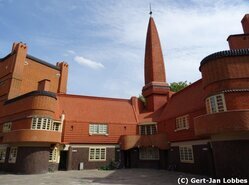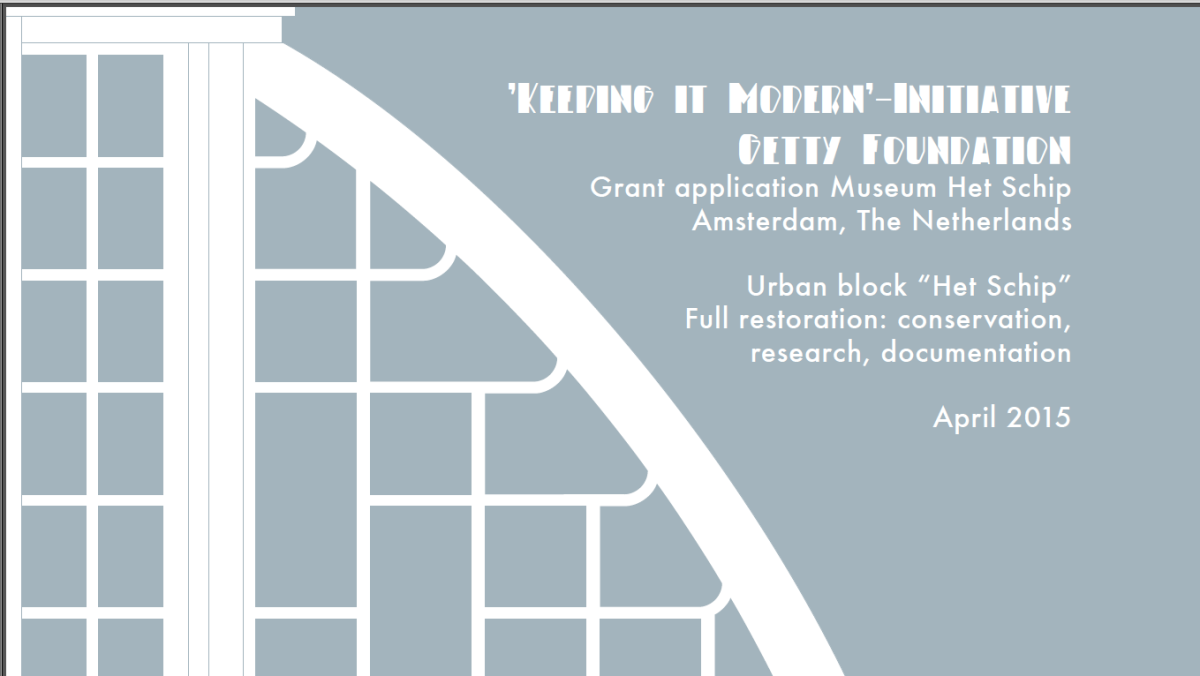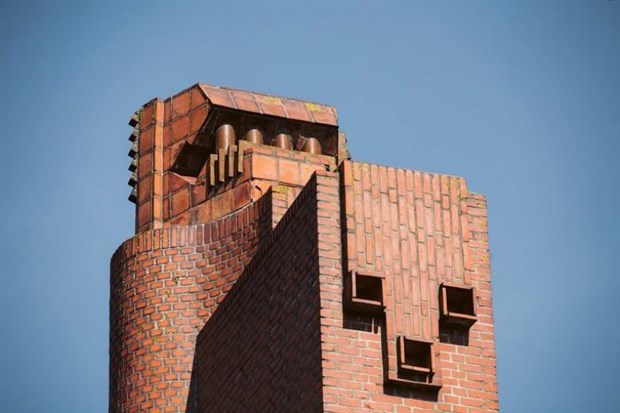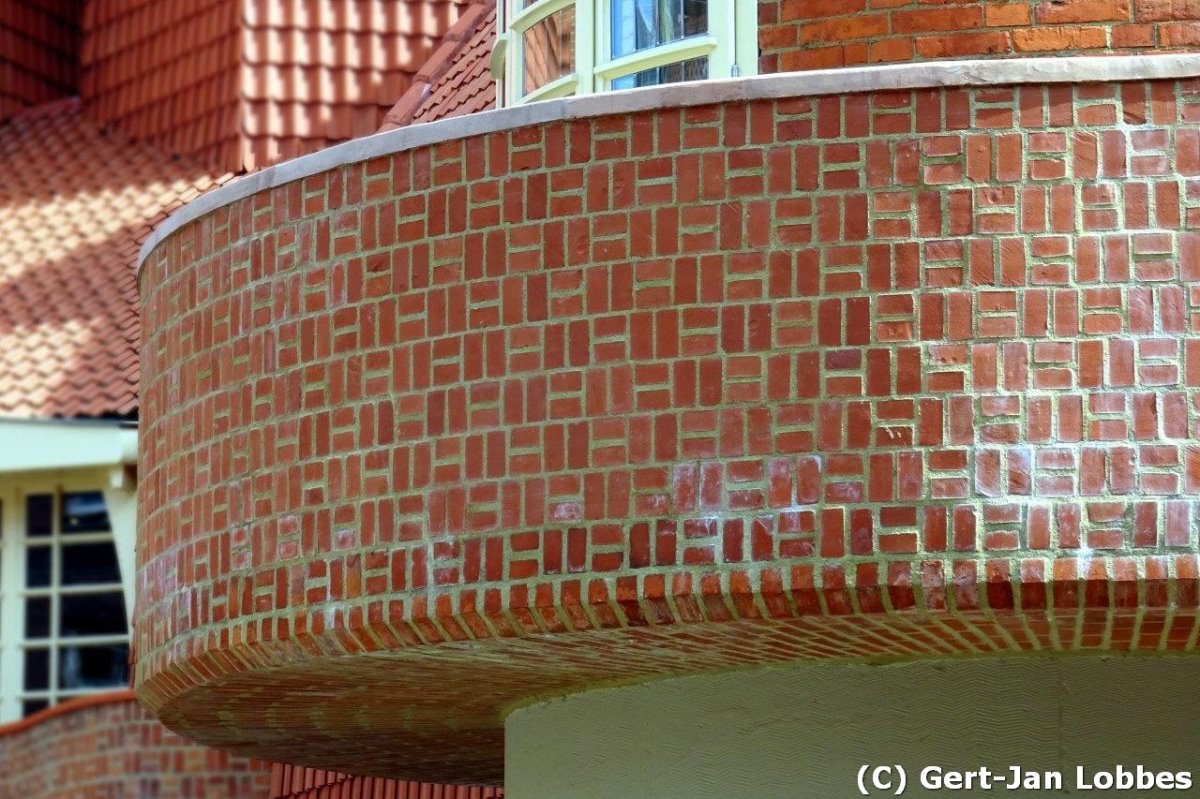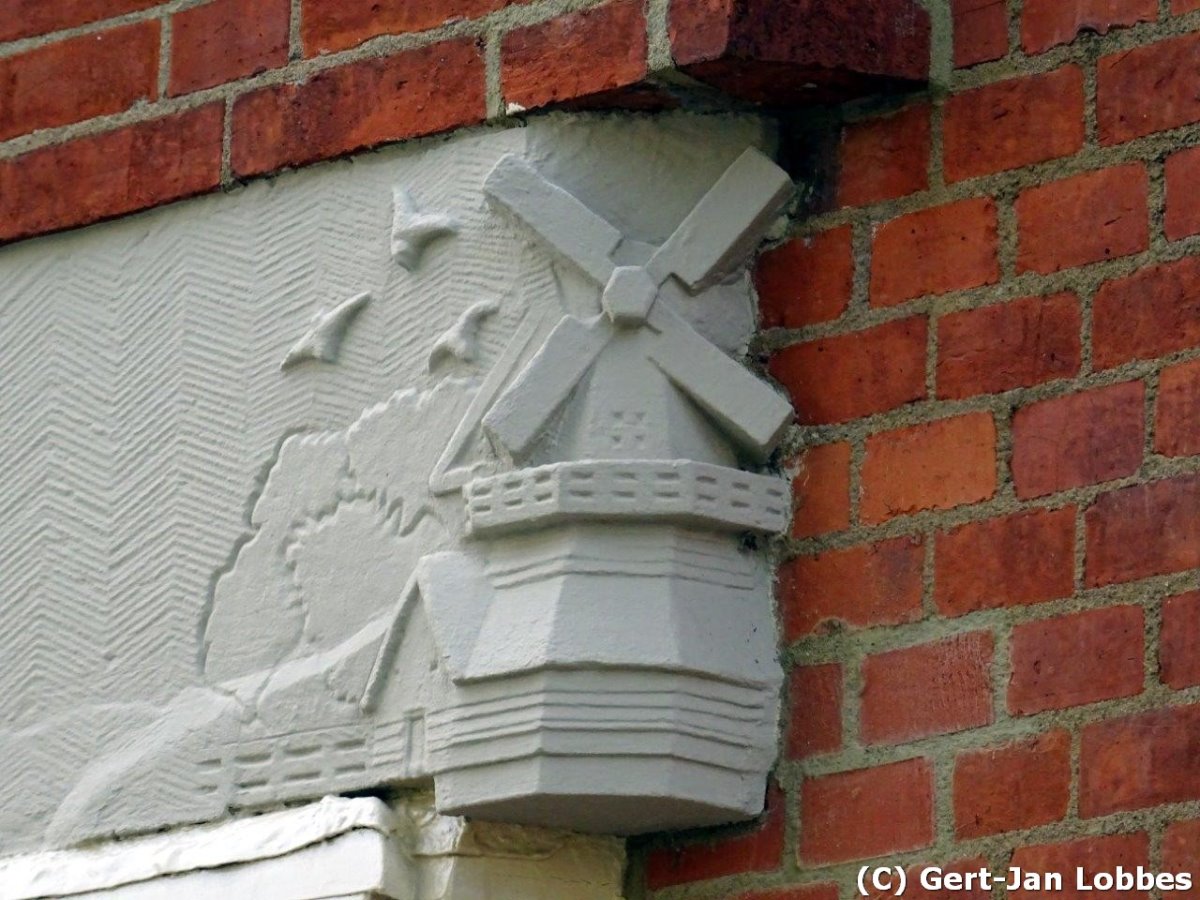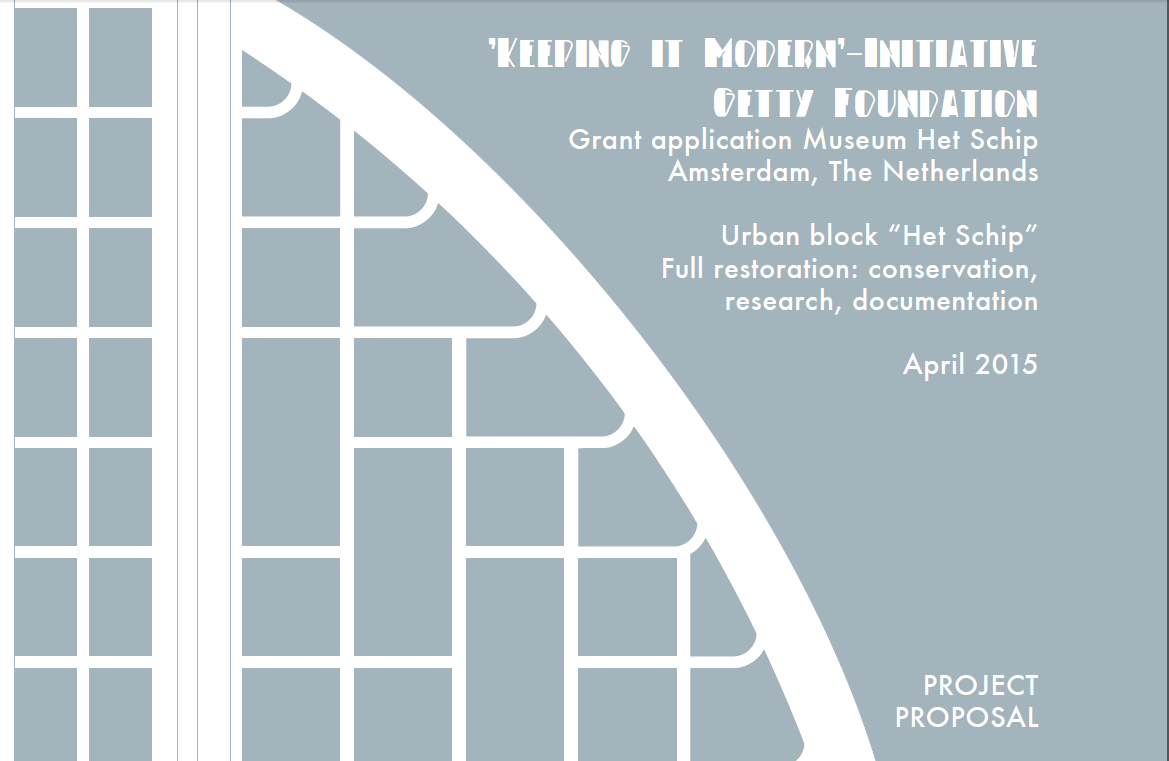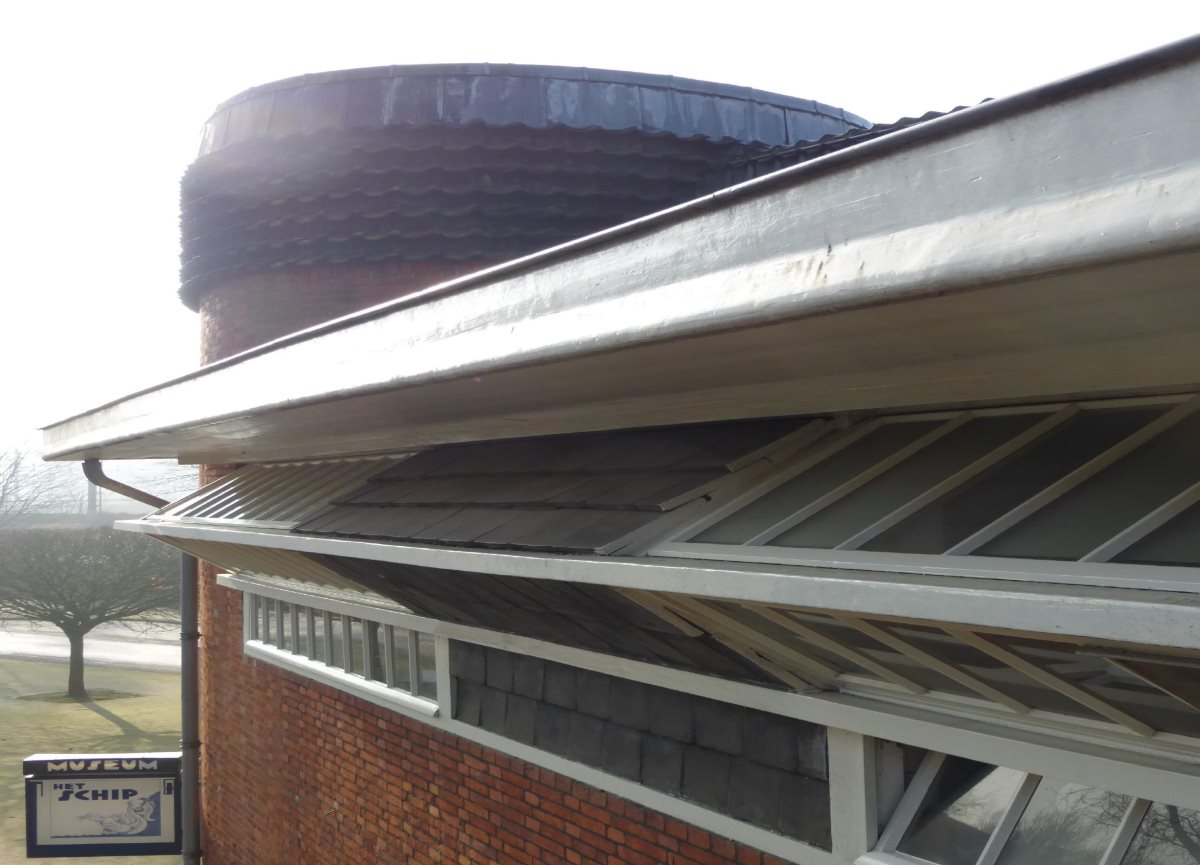Research Symbolism+Meaning

Many architectural and artistic details in Het Schip building, both figurative and abstract, are bearers of symbolic meaning. Many stories go around. Which are true and which are false? First time research into the sources of Michel de Klerk and contemporaries will be undertaken.
Getty Project proposal Het Schip on Symbolism and meaning of
architectural and artistic details, April 2015
The meaning of ornamental elements in urban block Het Schip (1921) by Michel de Klerk
This research project is to determine the meaning of ornamental elements in housing block Het Schip (1921), by Amsterdam School architect Michel de Klerk. A significant omission in the contemporary writings (1910s-1920s) devoted to the works of Michel de Klerk is a study of the direct meaning of architectural and artistic detail. While stressing the great importance of architectural detail (as opposed to ‘the whole’) in the works of De Klerk, no attention is directed to the meaning of autonomous detail or symbolic motives.
The first interpretations of ornament and detail date from the period of renewed interest in the Amsterdam School in the 1960s-1970s. A study of contemporary writings, not of the works of De Klerk, but on the nature of the arts, offers a new context for the interpretation of ornamental elements.
The proposed research covered under the Getty Foundation grant application aims to interprete the ornamental elements in the design of Het Schip, not just on iconographic grounds, but also on theoretical grounds.
The anticipated results of this research project are threefold:
- a publication about the meaning of representation in Het Schip;
- a presentation to the design team and the future care-keepers (among which the tenants) of housing block Het Schip;
- the results are to be used later as a case-study in a more comprehensive PhD research project on Amsterdam School.
The list of representational elements at Het Schip is subdivided in six groups, according to the nature of the ornaments:
- Autonomous sculpture (not expressing or communicating function)
- Figurative elements communicating or expressing function
- Other elements of communication, not related to function
- Other ornamental elements
- Abstract elements
- Figurative elements of the extension 1924-1925 (school building)
- (For the full list, see appendix 1)
The research will clarify whether the representational elements relate to the building’s architecture – are they an expression of the function? – and/or whether they concern non-architectural representational meanings, related to the ideas of the Amsterdam School. The question “What representational meanings are embedded in the design of Het Schip?” is to be answered in three sub questions:
- What representational elements do the works of Michel de Klerk contain, and how have these been interpreted in literature? This section covers an analysis of modern (since the renewed interest of the 1960s) writings on the architecture of the Amsterdam School, since contemporary criticism has not paid attention to the interpretation of representational elements.
- What notions of the relation between representational meaning and the nature of the different arts were held by artists and architects of the Amsterdam School, and their contemporaries? This section covers an analysis of contemporary writings on the nature of architecture and the nature of other arts, as well as the relations between the arts.
- What meaning-determining elements are of significance for the interpretation of the representational elements in Het Schip? This section covers an analysis of the writings of members of the Amsterdam School, and their contemporaries, to determine what meaningdetermining elements are relevant to the reading of the elements of representation in Het Schip.
The meaning-determining elements taken into consideration are: symbolic meaning of sculpture, composition, color, material, and spatial orientation (absolute orientation, orientation in relation to the environment, existence of sightlines).
Researcher: Richelle Wansing M.A.
Supervision: Alice Roegholt (Museum Het Schip), Vladimir Stissi (University of Amsterdam), Wim de Wit (Stanford University).
Appendix 1 to the Getty project proposal Het Schip, April 2015
Research on Symbolism and meaning of crafted details
The meaning of ornamental elements in building block Het Schip (1921) by Michel de Klerk
Full listing of ornaments:
Autonomous sculpture (not expressing or communicating function):
- Exterior post office: brick sculpture of birds
- Exterior building: monumental/animal head like chimney top executed in tiles (2x)
- Exterior building: sandstone sculpture of windmill (2x)
- Exterior post office: wooden sculpture of two dogs, and text ‘postkantoor’ (post office)
- Exterior post office: stone sculpture flash of lightning (2x), and stone sculpture of horn (2x)
- Interior post office: wooden flagpole with on top a wooden sculpture of a crown (2x)
- Interior post office: flag executed in stained glass (2x)
- Interior post office: sign ‘forbidden’
- Interior post office: door telephone booth executed in wood & stained glass with motive of a telephone pole and bird on a wire
Other elements of communication, not related to function:
- Exterior building: the year 1919, 1) in sandstone, 2) in wrought iron
- Exterior community house: the year 1920, and text ‘Eigen Haard’, both in brick
- Exterior post office: stone sculpture under balcony, jellyfish or mushroom like
- Exterior post office: stone sculpture entrance post office, combined with house number
- Tower entrance post office: top ornament
- Tower Hembrugstraat: top ornament
Abstract elements:
- Plasticity of shapes
- Color and color contrast in interior post office, bricks, mortar, and tiles
- Exterior: sculpture of a horse (3x)
- Exterior: sculpture of a man
- Exterior: woodcarving of an archer with wild life
- Interior: wooden sculpture of the head of a horse (ornament wooden stairs)
Description of the proposed research
In 1916, the Belgian architect Hub. Hoste ‘congratulated’ Holland with the great honor that the Dutch architects of the Amsterdam School were the first to explore a new direction in architecture – surpassing France and England. Hoste’s understanding of the Amsterdam School as an expression of non-materialist idealism, stresses a spiritual striving similar to the members of the De Stijl movement, founded in 1917. De Stijl distinguished itself as an intellectual movement, defining itself in theoretical writings. According to De Stijl, the difference between the arts could be understood in terms of the unique qualities (or possibilities) of representation by each art. As opposed to De Stijl, the Amsterdam School distinguished itself as an anti-intellectual, intuitive movement, based on the notion that artistic creation springs from feeling instead of being based on ratio. Notwithstanding the lack of theoretical explanation, the Amsterdam School was unmistakably grounded in a strong sense of artistic awareness. Architecture, as Michel de Klerk stated in 1916, had to do no more than to return to its roots in art. It is to say that such artistic awareness can only exist when being firmly grounded in a notion of the nature of the arts.
When the Amsterdam School is taken into consideration in relation to contemporary (1910s-1920s) theoretical reflections on the nature of the arts, this opens up the question to the nature of the arts, more specifically to the meaning of representation in the arts.
The Amsterdam School’s notion of the nature of the arts, is commonly understood as a notion of the nature of architecture as a ‘total work of art’ (Gesamtkunstwerk). Architects of the Amsterdam School had a natural understanding of the concept of a total work of art, rooted in the nineteenth century concept of ‘communal art’. The Amsterdam School members supposedly believed in a future society in which all the different disciplines would merge. Interestingly, in the writings of Amsterdam School members ‘merging’ does not appear as a quality of communal art. As opposed to ‘merging’, the historic discourse about the Amsterdam School concentrated on the new values of the architecture, namely of ‘individualism’ and ‘artistic devotion’, which resulted in an architecture of plasticity, of sculptural effect.
A significant omission in contemporary (1910s-1920s) value-based criticisms is the direct meaning of ornament and detail. While in recent literature interpretations have been given of certain iconographic and abstract motives in the design of Het Schip, no research has yet been done to the meaning of representation in Amsterdam School thought. Contemporary reflections on the nature of the arts, offers a new context for interpretation of representational elements. The research question can be formulated as follows: What representational meanings are embedded in the design of Het Schip? This question is to be answered in three sub questions:
- What representational elements do the works of Michel de Klerk contain, and how have these been interpreted in literature? This section covers an analysis of modern (since the renewed interest of the 1960s) writings on the architecture of the Amsterdam School, since contemporary criticism has not paid attention to the interpretation of representational elements.
- What notions of the relation between representational meaning and the nature of the different arts were held by artists and architects of the Amsterdam School, and their contemporaries? This section covers an analysis of contemporary writings on the nature of architecture and the nature of other arts, as well as the relations between the arts.
- What meaning-determining elements are of significance for the interpretation of the representational elements in Het Schip? This section covers an analysis of the writings of members of the Amsterdam School, and their contemporaries, to determine what meaningdetermining elements are relevant to the reading of the elements of representation in Het Schip.
The meaning-determining elements taken into consideration are: symbolic meaning of sculpture, composition, color, material, and spatial orientation (absolute orientation, orientation in relation to the environment, existence of sightlines).
Literature (provisional)
General
- Bock, M. 1997. ‘Inleiding,’ 9-25 in Michel de Klerk; Bouwmeester en tekenaar van de Amsterdamse School, 1884-1923.
- De Klerk, M. 1916. ‘De invloed van Dr. Berlage of de ontwikkeling der Nederlandsche bouwkunst,’ 331-332 in Bouwkundig Weekblad 1916.
- ‘Moderne architectuur in Holland’, (1916) Leeuwarder Courant 23 november 1916.
- H.H. [Hub. Hoste] 1916. ‘Bouwblokken III. Spaarndammerplantsoen’, De Telegraaf 12 januari 1916.
- Johannisse, S. 1997. ‘Eenheid, beweging en ruimte,’ 26-55 in Michel de Klerk; Bouwmeester en tekenaar van de Amsterdamse School, 1884-1923.
- Stissi, V.V. 1997. ‘De woningblokken van De Klerk,’ 56-93 in Bock, M, Johannisse, S. & V. Stissi in Michel de Klerk; Bouwmeester en tekenaar van de Amsterdamse School, 1884-1923.
- Wils, Jan. 1918. ‘Beeldbouwkunst,’ 12-14 in Wendingen, jaargang 1, nr. 6.
Introduction/sub question 1
- NAI; archief De Klerk [studie oorspronkelijke tekeningen-elementen-ontwerpproces]
- Casciato, M. 1991. De Amsterdamse School.
- Frank, S.S. 1970. Michel de Klerk, 1884-1923. An architect of the Amsterdam School
- Museum Het Schip 2012. Arbeiderspaleis Het Schip.
- Searing, H. 1971. Housing in Holland and the Amsterdam School.
- Van Burkom, F. 1990. Michel de Klerk: bouwen meubelkunstenaar (1884-1923)
- Van Burkom, F. [ed.] 2009. Kunst aan de straat: behoud van Amsterdamse beelden op bruggen en gebouwen uit het interbellum.
- Vriend, J.J. 1970. Amsterdamse School
Chapter 1/sub question 2
Contemporaneous reviews/critique
- Blauw, C.J. 1918. ‘De beweeglijkheid van de bouwkunst der laatste dagen,’ 3-8 in Wendingen jaargang 1, nr. 2.
- De Klerk, M. 1916. ‘De invloed van Dr. Berlage of de ontwikkeling der Nederlandsche bouwkunst,’ 331-332 in Bouwkundig Weekblad 1916.
- Endt, P.H. 1918. ‘Amsterdamse School,’ 3-5 in Wendingen jaargang 1, nr. 7.
- Godefroy, J. [1911-1923] Handboek voor kunstgeschiedenis, stijl- en ornamentleer.
- Havelaar, Just (1920). De symboliek der kunst.
- Havelaar, Just (1922). Het sociaal conflict in de beeldende kunst.
- Havelaar, Just (1923). Het leven en de kunst.
- Havelaar, Just (1928). Hildo Krop. Lauweriks [symbolen?]
- Oud, J.J.P. 1916. ‘Over cubisme, futurisme, moderne bouwkunst, enz.’ 156-157 in Bouwkundig Weekblad 1916.
- Oud, J.J.P. 1916. ‘De moderne en modernste bouwkunst,’ 341-343 in Bouwkundig Weekblad 1916.
- Oud, J.J.P. 1918. ‘Glas in lood van Theo van Doesburg,’ 201-202 in Bouwkundig Weekblad 1918.
- Roland Holst, R.N. 1927. Over vrije en gebonden vormen in de plastische kunst.
- Van Doesburg, Th. 1924. ‘De nieuwe architectuur. Korte samenvatting der
- architectuurprincipes gedurende 1916 tot 1923 door den stijlgroep in Holland practisch en theoretisch ontwikkeld,’ 200-204 in Bouwkundig Weekblad 1924.
- Van Loghem, J.B. 1916. ‘Bouwmeester en kunstnijveraar,’ 223-224 in Bouwkundig Weekblad 1916.
- Van Loghem, J.B. 1917. ‘Twee moderne uitingen,’ 287-288 in Bouwkundig Weekblad 1917.
- Van Loghem, J.B. 1918. ‘De eenheid in de komende kunst,’ 15-16 in Wendingen jaargang 1, nr. 5.
- Verkruysen, H.C. 1917. De verhouding der kunsten.
- Verkruysen, H.C. 1918. Het schoonheidsbegrip benevens eenige gedachten over symboliek.
- Verkruysen, H.C. 1924. ‘Beeldhouwwerk in verband met architectuur,’ in Wendingen jaargang 6, nr. 1.
- Wils, Jan. 1918. ‘Beeldbouwkunst,’ 12-14 in Wendingen, jaargang 1, nr. 6.
Chapter 2/sub question 3
Recensies in vakbladen.
Overige literatuur:
- Blotkamp, C. 1978. Kunstenaren der idee. Symbolistische tendenzen in Nederland ca. 1880-1930.
- De Heer, Jan [ed.] 1986. Kleur en architectuur.
- Dosi-Delfini, L. 2004. The Furniture Collection Stedelijk Museum Amsterdam 1850-2000; From Michael Thonet to Marcel Wanders. [kleur in de meubelen van Kramer vs. Rietveld: http://www.stedelijk.nl/tentoonstellingen/kramer-vs-rietveldcontrasten-in-de-meubelcollectie]
- Koopmans, Y. 1994. H. A. van den Eijnde, 1869-1939.
- Koopmans, Y. 2006. John Rädecker; de droom van het levende beeld.
- Kropholler, A.J. 1938. Kunst en leven. Lijn en vorm, licht en kleur in bouw- en aanverwante kunst.
- Lagerweij-Polak, E.J. 1992. Hildo Krop; beeldhouwer.

